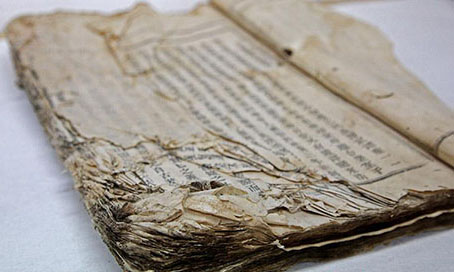Ancient book restorers in high demand

An ancient book needs to be restored.
“The biggest problem for us now is not lack of funding or equipment, rather we are in need of restorers, especially restorers of rare books in foreign languages,” Wei Tao said.
Wei is a restorer of ancient documents in special collections at Sichuan University. His work table is occupied by paperweights made of camphorwood, brushes, tweezers and other tools accumulated over the past decade during his efforts to restore ancient books.
On his desk, Wei works on moth-eaten, moldy, damaged ancient books one after another. Each day he restores one to three pages. Ancient books, damaged to the extent that even turning the page was not possible, are given new lives in the hands of restorers.
Ancient books refer to those produced before 1912, while rare books are those produced before the sixtieth year of Emperor Qianlong’s reign (1736-95). According to statistics from the country’s Conservation Center for Ancient Books, there are now 50 million ancient books in official storage, and more than 2,800 units doing restoration work.
“Sometimes it takes one year or more to restore an ancient book, giving people the impression that the work is dull and boring,” Wei said. There are more than 10 procedures involved in restoring ancient books, including dismantling, coding, arranging, repairing, folding, clipping, watering, squeezing and hammering.
One principle of ancient book restoration is to restore books to their original appearance, or retain every trace originally presented on each book’s cover, slip sheet and damaged bookmark. The highest level of expertise in this area demands that the restored materials can only be perceived under light, which Wei added may only be seen within two millimeters from the edge of the books.
“Major damage to ancient and rare books are bites by insects, imbalance of acid base and mustiness due to dampness,” Wei said. Especially in Sichuan Province, which has damp weather, pages of ancient books can stick to each other. Restoring each ancient book is therefore a race against time.
“We are short of restorers of ordinary ancient books, let alone restorers who are experts of two languages and can restore ancient books written in foreign languages,” Wei said. In 2015, both Fudan University and Sun Yat-sen University launched majors in ancient book restoration, despite drawing unsatisfactory numbers of students.
Take the library in Sichuan University as an example. The total collection of ancient books amounts to 300,000 volumes, among which are large quantities of block-printed books of the Song (960-1279) and Yuan (1206-1368) dynasties, and various books and copies written after the Tang Dynasty (618-907). There are also 20,000 rare books in foreign languages. Nevertheless, there are only three experts engaged in restoration work.
Luo Lin, a professor from the National Science Library at the Chinese Academy of Sciences, said that rare foreign-language books require high-restoration techniques. Now, this work is usually done through cooperation between Chinese and foreign experts.
“The Chinese Ancient Books Preservation Project came into operation in 2007, when there were less than 100 ancient book restorers,” Luo said. Although more and more people have become involved in restoration efforts in recent years, there are still far too few experts.
